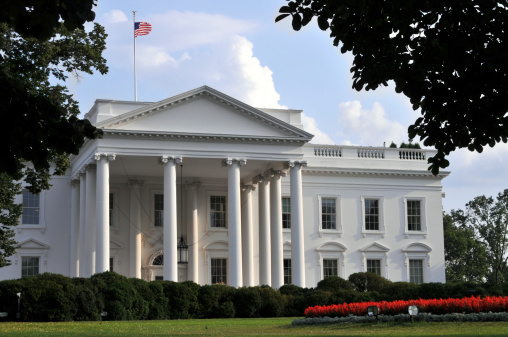
When it comes to brokering settlements, presidential power may need to be regulated.
As oil gushed uncontrollably miles beneath the surface of the Gulf of Mexico, President Obama called BP’s chief executives to the White House on June 15, 2010 to negotiate compensation for thousands of fishermen, businesses, and coastal residents devastated by the spill. According to participants, the talks mirrored eleventh-hour negotiations often seen in mass tort litigation. Government lawyers and company executives—themselves, represented by former-government lawyers—haggled over the details of the compensatory scheme in a White House meeting that stretched past midnight. But instead of private attorneys bargaining on the steps of a courthouse, the final settlement culminated in a dramatic, private, twenty-five minute session between BP’s chairman and President Obama, “under the famous portrait of a charging Theodore Roosevelt on horseback.”
The final agreement contained many features of a sprawling class action settlement, including an independent $20 billion fund, an experienced special master, and a distribution scheme for hundreds of thousands of oil spill victims. But unlike a class action, no court approved the overarching terms of the deal. Nor did any process exist for victims’ representatives to formally participate in discussions over the structure of the settlement. The resulting “Gulf Coast Claim Facility” materialized outside any kind of traditional court process. It was, by its terms, a presidential settlement.
President Obama’s highly publicized efforts to resolve disputes on behalf of private citizens and the nation, like BP’s oil spill fund, are hardly unique. Over the course of American history, large groups repeatedly have turned to the White House to collectively resolve private disputes. The results have produced settlement commissions responsible for losses associated with the Revolutionary War and Civil War, the sinking of the Lusitania, and attacks on the United States border following the 1910 Madero revolution in Mexico. More recent presidential efforts have produced blockbuster mass compensation schemes like the Iran-American Tribunal, the Holocaust victim settlement, the settlement of claims arising out the bombing of Pan Am 103 over Lockerbie, Scotland, and, most recently, the 2012 mortgage foreclosure settlement.
Such presidential settlements have long pushed the boundaries of America’s separation of powers, while raising new questions about the most effective way to compensate victims of mass disasters. For example, the Jay Treaty of 1794, one of earliest mass compensation schemes brokered by a presidential administration, precipitated some of the earliest constitutional confrontations among the branches about the proper scope of executive power. During the Progressive Era, Teddy Roosevelt himself famously brokered many settlements, arguing that they constituted historic moments that required presidents to act as “stewards of the people.” He believed that presidents had a duty to act to resolve disputes with national implications unless specifically constrained by prohibitions in the Constitution or imposed by Congress.
Over the course of the twentieth century, presidents have followed suit—most recently in mass compensation agreements brokered by presidential “Task Forces” of federal, state, and local law officers. In many cases, victims benefit when a politically accountable actor like a president resolves claims to compensate large groups of people, while accounting for broader policy concerns, like deep-water drilling reforms or fairer banking procedures. Unlike private lawyers, who courts appoint to represent victims without their consent in mass litigation, voters themselves choose government officials to represent their interests. Although some complain that class action settlement schemes sometimes resemble illegitimate “private administrative agencies,” the result of a presidential settlement ironically grows out of negotiations by the Chief Executive, who oversees many real-life administrative agencies.
But this phenomenon may create problems for groups purportedly served by presidential settlements. First, presidential involvement usually means that negotiations lack procedures thought necessary to protect victims in large settlements. Separation-of-powers principles limit practices of judicial review, transparency, and plaintiff participation ordinarily used to resolve potential conflicts of interests among the parties to mass compensation schemes. Presidents even have more discretion when negotiating settlements than other public officials, who must follow rules designed to ensure they hear from impacted parties and explain their decision-making. Rules contained in the Administrative Procedure Act, sunshine-in-government laws, and various victim rights’ statutes do not constrain the president. We may want presidents to enjoy more discretion in settlement negotiations, but too much discretion can be abused, particularly when money is changing hands.
Second, presidential settlements have constitutional consequences. When presidents step in to shape policies without objection from Congress, courts may defer to that historical practice as a constitutional “gloss” on what the President can do without congressional approval— expanding presidential discretion even further.
Rather than eliminate presidential settlements, which may offer the only source of relief to victims of mass harm, such settlements may be improved by borrowing principles from complex litigation. To be sure, complex litigation suffers from its own flaws. But, over time, complex litigation scholars, lawyers, and judges have found creative ways to promote group representation and dissent, avoid conflicts of interests, and collect information using bellwether trials and statistics. Presidents need not, of course, rigidly adhere to complex litigation rules to resolve mass compensation claims. But by adopting such procedures as guidelines, presidents and their attorneys can take steps to improve participation, legitimacy, and fairness for victims, without unduly constraining the Chief Executive’s role in resolving national disputes that impact the public interest.
In other contexts, the president has voluntarily decided to follow a number of internal checks and balances. Certain aspects of the modern presidency are already constrained by rules, norms, and tools that function much like those used by judges in large settlements, who rely on special masters, court appointed experts, and other government entities to evaluate sprawling deals that impact the public interest. A president may also prefer to shift blame for any problems with the settlement process to an independent adjudicator or arbitrator, who then might be suitably constrained by rules and procedures.
Still, seeing the president as a “settler-in-chief” raises thorny questions about presidential power. In addition to constitutional concerns about presidential overreach, the extensive and continuing practice of presidential settlement means that presidents have opened themselves to many of the same complaints raised about courts when they oversee mass settlements. Just as critics complain about “activist” judges in mass disputes, executive officers have opened themselves to an analogous complaint when they press against the boundaries of executive authority by adjudicating claims of mass harm. Perhaps there is something about the nature of any large-scale relief effort that—when undertaken by courts, legislatures, or presidents—strains the delicate balance of powers between the branches to their limit.
None of this means that presidents should abandon efforts to respond to large crises that impact public and private interests. But it does mean we should try to find ways to identify the proper boundaries of executive discretion in such settlements, promote participation and transparency where possible, and protect individual complainants who depend on the government for relief from mass harm.
This piece draws on the author’s recent publication, Presidential Settlements, which will appear in the University of Pennsylvania Law Review.




